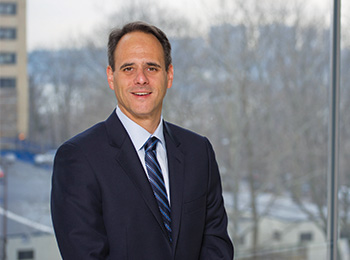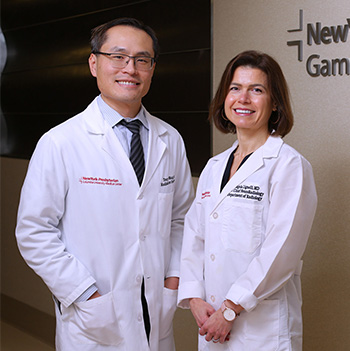Addressing the Ongoing Challenge of Glioblastoma
At NewYork-Presbyterian/Columbia University Irving Medical Center, Andrew B. Lassman, MD, Chief, Division of Neuro-Oncology and Co-Director of the Brain Tumor Center with Jeffrey N. Bruce, MD, Vice Chairman of Academic Affairs for Neurological Surgery; Peter D. Canoll, MD, PhD, Director of Neuropathology; Tony J. Wang, MD, Co-Director of the Center for Radiosurgery; and Angela Lignelli, MD, Section Chief of Neuroradiology, are colleagues and collaborators on a multidisciplinary team that brings highly specialized expertise to bear on the relentless treatment challenges of malignant brain tumors. The most prevalent and most aggressive of these in adults is glioblastoma (GBM), which carries a median overall survival of 14 to 16 months. The inevitability of recurrence, an extremely poor prognosis, and the absence of effective therapies keep this devastating disease top of mind for Columbia’s neuro-oncology clinicians and researchers.

Dr. Andrew B. Lassman
Focusing on Epidermal Growth Factor Receptor Amplification
Approximately 50 percent of patients with glioblastoma have tumors that harbor Epidermal Growth Factor Receptor (EGFR) amplification – a potentially meaningful therapeutic target. Depatuxizumab mafodotin (depatux-m, formerly ABT-414) is an antibody-drug conjugate that specifically targets tumor cells expressing EGFR and has demonstrated efficacy in recurrent GBM (rGBM).
“Depatux-m is actually a three-part molecule. The first part is the antibody, which is injected intravenously every two weeks,” explains Dr. Lassman. “The second part of the molecule is the linker, and the third part is a toxin. Once bound to the epidermal growth factor receptor gene that is activated on the surface of glioblastoma cells and internalized, depatux-m releases the cytotoxin in the cell, leading to cell death. The antibody by itself is ineffective, and other approaches to using EGFR as a target of therapy in glioblastoma have failed, although they have all attempted to use drugs or approaches that inhibit EGFR signaling. Depatux-m does not use that approach. Instead, it uses what I think of as a guided missile. The EGFR antibody is the navigation system that guides the missile to the tumor; the toxin component of the molecule corresponds to the payload in the missile, which then explodes and kills the tumor cell.”
Depatux-m plus TMZ displayed an acceptable safety and pharmacokinetic profile in glioblastoma, and anti-tumor activity in this TMZ-refractory population was encouraging.
The safety and efficacy of depatux-m in combination with temozolomide (TMZ) in patients with EGFR-amplified rGBM was first evaluated in an international phase 1 multicenter trial, with results published in the January 1, 2019 issue of Neuro-Oncology. The open-label study encompassed 60 patients with newly diagnosed GBM or rGBM across three treatment arms. Depatux-m plus TMZ displayed an acceptable safety and pharmacokinetic profile in glioblastoma, and anti-tumor activity in this TMZ-refractory population was encouraging.
“These findings indicate that further study of depatux-m in glioblastoma is justified,” says Dr. Lassman, who was first author on the study. Continued study of depatux-m in patients with EGFR-amplified, newly diagnosed, or recurrent GBM is ongoing in two global phase 3 clinical trials. “The important aspect of molecular characterization of tumors is that it allows us to apply precision medicine approaches to treatments such as this one, which, at least based on the data thus far, elicits responses only in patients who have EGFR-amplified disease. But there is also a lot that we don’t know. Although EGFR amplification appears to be necessary for response, there are also patients who have EGFRamplified disease who don’t respond. It may be related to mutations in the tumor that affect sensitivity to the toxin part of the molecule. So this is another active area of ongoing investigation.”
In a recent presentation at the European Association for Neuro-Oncology in Stockholm, Sweden, Dr. Lassman was senior author of a study demonstrating the stability of EGFR amplification over time in longitudinally sampled glioblastomas intrapatient – same patient, more than one surgery. “Treatment with the EGFR antibody conjugate actually seemed to apply therapeutic pressure, and patients who had resection after that treatment had a reduction in the EGFR amplification in their tumor frequency as opposed to those who did not receive that treatment,” notes Dr. Lassman. “Further work with longitudinally sampled GBMs continues as well.”
Will Combined Therapies Extend Survival?
Dr. Lassman is now serving as the International Study Chair along with Dr. Tony Wang, who serves as the Radiation Oncology Co-Chair, a phase 3 clinical trial that is an academic-industry collaboration between the Radiation Therapy Oncology Group Foundation and AbbVie. The trial seeks to determine whether depatux-m added layered on top of standard treatment prolongs overall survival among patients with newly diagnosed EGFR-amplified GBM.
“When I was training, the median survival for patients at best was a year to a year and a half, and now when you look at some randomized trials, maybe we’re pushing it to two years median survival,” says Dr. Wang, a radiation oncologist specializing in brain tumors. “Unfortunately, we still have a ways to go. The treatment paradigm as of now for patients with newly diagnosed GBM is to maximally remove as much tumor as safely as possible followed by analysis of the tissue. Radiation therapy concurrent with chemotherapy, typically with temozolomide, then follows surgery. Here at Columbia, additional molecular markers are analyzed for mutations to see if there is anything possibly actionable for patients. That includes EGFR amplification status which is included in our trial.”
“There have been several other studies looking at improving the odds for patients because even with the chemotherapy and radiation, the survival benefit is still roughly a year and a half,” adds Dr. Wang. “It’s better than just giving radiation alone, and when you add TMZ in a randomized trial, it appears to improve patient survival by a few months. I am hopeful that this current trial will help improve the prognosis for our patients.” Recruitment has completed with more than 1,000 patients screened across hundreds of countries, and results are pending.
The Significance of Collaborations
Both Dr. Lassman and Dr. Wang emphasize that their clinical and research endeavors rely heavily on collaborations with Dr. Angela Lignelli. “Especially in our field of neuro-oncology, neuroradiology contributions are invaluable, providing key information, for example, about tumor progression or tumor response,” says Dr. Wang.
Dr. Lignelli’s particular specialty is advanced brain tumor imaging, including MR perfusion, MR spectroscopy, and functional MRI. This complements her primary research interests, which involve correlating anatomic and non-anatomic brain imaging of brain tumors with neuoropathologic markers and clinical outcomes.

Dr. Tony J. Wang and Dr. Angela Lignelli
Dr. Lignelli works closely with Dr. Peter Canoll, as well as neurologists and neurosurgeons, throughout diagnosis, treatment, and ongoing monitoring of patients with primary brain tumors. “I think what is unique to Columbia is not the availability of advanced brain tumor imaging, but rather that we use it routinely throughout the patient’s diagnosis and follow-up – it is essentially a standard part of patient care,” says Dr. Lignelli. “Brain tumors are smart. They can behave in different ways yet look the same anatomically. We use our advanced imaging methods to try and narrow down how the tumor is going to perform. The approach that our multidisciplinary team has devised is to examine all aspects of imaging together with the clinical variables in interdepartmental conferences in order to best guide the development of treatment plans for patients.”
One of the many advanced technologies Dr. Lignelli and her team have implemented over the past few years is MR spectroscopy focusing on 2-hydroxyglutarate, an in vivo marker for gliomas. “The reason this is important is because if this is positive, it has very high specificity in primary brain tumors, including glioblastomas, oligodendroglioma, and astrocytoma,” notes Dr. Lignelli. She is also pursuing research with Columbia neurosurgeons Dr. Jeffrey Bruce and Guy M. McKhann, MD, and Jack Grinband, PhD, Assistant Professor of Clinical Neurobiology, on resting state fMRI, an exciting new aspect of imaging that may show networks of connections where the brain tumor could, in theory, recur.
“As hard as it is working with patients with cancers that are so devastating, there’s always a glimmer of hope, and we focus on that,” adds Dr. Lignelli. “The team approach is a big part of what makes the future hopeful. Whether it’s surgery, medical interventions, radiation therapy, or imaging, we are encouraged by all of us working together toward the same goal.”


